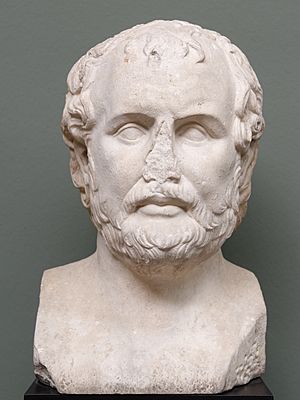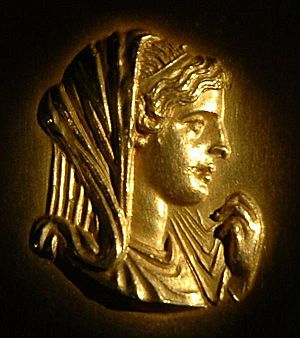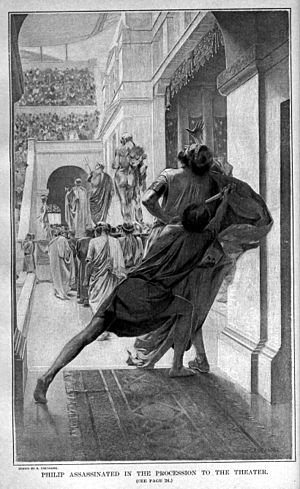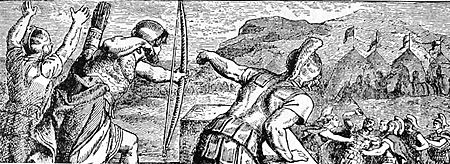Philip II of Macedon facts for kids
Quick facts for kids Philip II |
|||||
|---|---|---|---|---|---|

Bust of Philip II of Macedon from the Hellenistic period; Ny Carlsberg Glyptotek
|
|||||
| King of Macedonia | |||||
| Reign | 359–336 BC | ||||
| Predecessor | Amyntas IV | ||||
| Successor | Alexander the Great | ||||
| Hegemon of the Hellenic League | |||||
| Reign | 337 BC | ||||
| Successor | Alexander the Great | ||||
| Born | 382 BC Pella, Macedon (modern-day Pella, Greece) |
||||
| Died | 21 October 336 BC (aged 46) Aigai, Macedon (modern-day Vergina, Greece) |
||||
| Burial | Aigai, Macedon (modern-day Vergina, Greece) |
||||
| Wives |
|
||||
| Issue |
|
||||
|
|||||
| Greek | Φίλιππος | ||||
| House | Argead dynasty | ||||
| Father | Amyntas III | ||||
| Mother | Eurydice I | ||||
| Religion | Ancient Greek religion | ||||
Philip II of Macedon (born 382 BC – died 21 October 336 BC) was a powerful king of the ancient kingdom of Macedonia. He ruled from 359 BC until his death. Philip was part of the Argead dynasty, a royal family that founded the ancient kingdom. He is most famous as the father of Alexander the Great.
During his rule, Philip made Macedonia much stronger. He conquered and united most of Classical Greece. He did this by making big changes to his army, like creating the Macedonian phalanx. This was a new way of fighting that helped his soldiers win many battles. He also used powerful siege engines and was very good at diplomacy, making alliances through marriages.
After winning a major battle against Athens and Thebes in 338 BC, Philip created a group of Greek states called the League of Corinth. He was chosen as its leader and commander-in-chief. His plan was to invade the Achaemenid Empire (Persia). However, he was assassinated by one of his bodyguards. His son, Alexander, then became king and carried out the invasion of Persia instead.
Contents
Biography of Philip II
Early Life and Becoming King
Philip was the youngest son of King Amyntas III and Eurydice I. When his older brother, Alexander II, was assassinated, Philip was sent away as a hostage. First, he went to Illyria, then to Thebes (around 368–365 BC). Thebes was a very important city in Greece at that time. While in Thebes, Philip learned a lot about military strategies and diplomacy from a famous general named Epaminondas.
In 364 BC, Philip returned to Macedon. In 359 BC, his other brother, King Perdiccas III, died fighting the Illyrians. Before he died, Perdiccas had made Philip the regent (a ruler for a young king) for his baby son, Amyntas IV. But Philip soon took the kingdom for himself.
Philip quickly showed his great military skills. He had to fix many problems in Macedonia, especially after the defeat by the Illyrians. The Paeonians and Thracians had attacked eastern Macedonia. Also, the Athenians had landed on the coast with a rival who wanted to be king.
Military Achievements
Improving the Army
Philip used diplomacy to push back the Paeonians and Thracians, promising them payments. He then defeated 3,000 Athenian soldiers in 359 BC. Once his immediate enemies were dealt with, he focused on making his kingdom stronger, especially his army.
Philip II made many important changes to the Macedonian army:
- He greatly increased the number of soldiers, both cavalry (soldiers on horseback) and infantry (soldiers on foot).
- He improved the discipline and training of his soldiers.
- Soldiers could now get promoted and earn rewards for good service.
- He created the Macedonian phalanx, a new infantry formation. Soldiers in the phalanx used a very long spear called a sarissa. Philip is given credit for adding the sarissa to the army, and it became their main weapon.
Early Battles and Conquests
Philip married Audata, who was related to the Illyrian king Bardyllis. But this marriage did not stop him from attacking the Illyrians in 358 BC. He defeated them in a battle where about 7,000 Illyrians died. This victory helped Philip control the land around Lake Ohrid and gain the support of the Epirotes.
After making his western and southern borders safe, Philip attacked Amphipolis in 357 BC. This city was important because it was near the gold mines of Mount Pangaion. Athens had tried and failed to conquer Amphipolis. Philip made a deal with Athens: he would give them Amphipolis after he conquered it, in exchange for Pydna. However, after taking Amphipolis, Philip kept both cities for himself. Athens then declared war on him.
Philip then allied with the Chalcidian League of Olynthus. He conquered Potidaea and, this time, gave it to the League in 356 BC.
In 357 BC, Philip married Olympias, a princess from Epirus. Their son, Alexander, was born in 356 BC. In the same year, Philip's racehorse won at the Olympic Games.
During 356 BC, Philip conquered a town called Crenides and renamed it Philippi. He put a strong army there to control its gold mines. The gold from these mines helped pay for his future military campaigns. Meanwhile, his general Parmenion defeated the Illyrians again.
From 355–354 BC, Philip attacked Methone, the last city on the Thermaic Gulf controlled by Athens. During this attack, Philip was injured in his right eye, which later had to be removed. Even though two Athenian fleets arrived, the city fell in 354 BC. Philip also attacked other cities on the Thracian coast.
The Third Sacred War
Philip became involved in the Third Sacred War (356–346 BC) in 354 BC. He helped the Thessalian League capture Pagasae, which led to an alliance with Thebes. A year later, Philip was asked to help again, this time against a ruler named Lycophron. Philip invaded Thessaly and defeated 7,000 soldiers.
Later that year, another general defeated Philip in two battles. But Philip returned the next summer with a much larger army. At the Battle of Crocus Field, 6,000 enemy soldiers died, and 3,000 were captured. This battle made Philip very famous and allowed him to take control of Pherae. He became the leader of the Thessalian League, expanding his territory. Philip did not try to go further south into Greece because the Athenians had blocked the way.
From 352 to 346 BC, Philip focused on conquering the Balkan hill-country to the west and north. He also took control of Greek cities along the coast. He pretended to be friends with Olynthus, a major coastal city, until he had taken all its neighboring cities.
In 348 BC, Philip began to attack Olynthus. The city had once been his ally but later sided with Athens. However, Athens could not help Olynthus because they were dealing with a rebellion. Philip captured Olynthus in 348 BC and completely destroyed it. Other cities in the area also suffered the same fate, and the Chalcidian League broke apart.
With Macedonia and its surrounding areas now secure, Philip held his own Olympic Games at Dium. In 347 BC, he continued conquering eastern areas and forced a Thracian prince to surrender. In 346 BC, he helped end a war between Thebes and the Phocians. His wars with Athens continued on and off, but Athens eventually sought peace.
Later Campaigns (346–336 BC)
After bringing many Greek city-states under his control, Philip II turned his attention to Sparta. He warned them, "If I invade Laconia, I shall turn you out." The Spartans famously replied with just one word: "If." Philip did invade Laconia, destroying much of it and taking land from the Spartans.
In 345 BC, Philip fought a difficult campaign against the Ardiaioi people. During this fight, Philip was seriously wounded in his lower right leg.
In 342 BC, Philip led a military trip north against the Scythians. He conquered a Thracian settlement and renamed it Philippopolis (modern Plovdiv) after himself.
In 340 BC, Philip began attacking Perinthus, and in 339 BC, he attacked Byzantium. Both attacks failed, which weakened his influence over Greece. However, he regained his power in the Aegean by defeating an alliance of Thebans and Athenians at the Battle of Chaeronea in 338 BC. In the same year, he destroyed another city for illegally using land. These important victories led to Philip being recognized as the military leader of the League of Corinth. This was a group of Greek states allied against the Persian Empire. Members of the league agreed not to fight each other.
Plans for Asia (336 BC)
Philip II had been interested in the Achaemenid Empire (Persia) for a long time. From around 352 BC, he supported several Persian opponents of the Persian king. He welcomed them as exiles in Macedonia, which gave him a good understanding of Persian affairs. This might have even influenced some of his new ideas for running Macedonia. Alexander also met these Persian exiles when he was young.
In 336 BC, Philip II sent his general Parmenion with an army of 10,000 men into Asia Minor (modern-day Turkey). Their job was to prepare for an invasion to free the Greeks living on the western coast and islands from Persian rule. At first, things went well. Greek cities on the western coast of Anatolia rebelled against Persia. But then news arrived that Philip had been assassinated, and his young son Alexander had become king. Philip's death made the Macedonian soldiers lose heart, and they were later defeated by the Persians.

Marriages and Family
Kings of Macedon often had many wives. Philip II had seven wives during his life, all from royal families in other lands. All of Philip's wives were considered queens, and their children were also royalty. The exact dates of Philip's marriages and the names of some of his wives are still debated by historians. Here is a list of his wives:
- Audata: Daughter of the Illyrian king Bardyllis. She was the mother of Cynane.
- Phila of Elimeia: Sister of Derdas and Machatas.
- Nicesipolis of Pherae, Thessaly: Mother of Thessalonica.
- Olympias of Epirus: Daughter of Neoptolemus I. She was the mother of Alexander the Great and Cleopatra.
- Philinna of Larissa: Mother of Arrhidaeus, who later became Philip III of Macedon.
- Meda of Odessos: Daughter of King Cothelas of Thrace.
- Cleopatra: Niece of general Attalus. Philip renamed her Cleopatra Eurydice of Macedon.
Assassination of Philip II
King Philip was assassinated in October 336 BC in Aegae. This was the ancient capital and burial place of the kings of Macedon. Philip and his royal court were gathered to celebrate the marriage of his daughter, Cleopatra of Macedon, to Alexander I of Epirus. As the king was entering the town's theatre, he walked without bodyguards to appear friendly to the Greek diplomats and important guests.
Suddenly, Pausanias of Orestis, one of his seven bodyguards, attacked and killed him. The assassin tried to escape to his friends who were waiting with horses. But three of Philip's other bodyguards chased him. During the chase, Pausanias's horse tripped, and he was killed by the bodyguards.

Philip II's Tomb at Aigai
In 1977, a Greek archaeologist named Manolis Andronikos began digging at the Great Tumulus (a large burial mound) at Aigai, near modern Vergina. He found that two of the four tombs in the mound had not been disturbed since ancient times. These two tombs, especially Tomb II, contained amazing treasures and very well-made objects.
For some years, there was a lot of discussion, but it is now believed that Tomb II belongs to Philip II. Many clues point to this. For example, one of the leg guards found in the tomb was shaped to fit a leg with a broken shin bone. Philip II was known to have broken his shin bone. Also, the skull found in the tomb shows damage to the right eye, which matches a historical record that Philip was injured in the eye by an arrow.
Some scientists claimed in 2015 that Philip was buried in Tomb I, not Tomb II. They based this on the age of the bones and a knee problem that matched Philip's lameness. However, the Greek Ministry of Culture said this claim was wrong. They stated that the archaeological evidence shows the knee problem belonged to another body placed in Tomb I after it had been robbed. More recent research continues to support that Tomb II holds the remains of Philip II.
Legacy of Philip II
Honors and Recognition
A special building called a heroon at Vergina (the ancient city of Aegae) is thought to have been built to honor the family of Alexander the Great. It might have held a statue of Philip. It is likely that he was seen as a hero or even a god after his death.
Even though Macedonians did not consider Philip a god, he received other honors from the Greeks. For example, at Eresos, an altar was built for him. At Ephesos, his statue was placed in the temple of Artemis. And at Olympia, a building called the Philippeion was built in his honor.
One writer, Isocrates, once told Philip that if he defeated Persia, there would be nothing left for him to do but become a god. Another person suggested that Philip should be considered the thirteenth god. However, there is no clear proof that Philip was officially given the divine status that his son Alexander later received.
Philip II in Stories and Games
Philip II has been shown in many movies and games:
- Fredric March played Philip II in the movie Alexander the Great (1956).
- Val Kilmer played Philip II in Oliver Stone's movie Alexander (2004).
- Sunny Ghanshani played Philip II in the TV series Porus.
He also appears in video games:
- Hegemony Gold: Wars of Ancient Greece is a PC strategy game that lets you follow Philip II's campaigns in Greece.
- Philip II appears in the Battle of Chaeronea in Rome: Total War: Alexander.
- Philip II is a card in the Macedonian civilization deck in Imperium: Classics.
- Philip II appears in the Ancient Greece tutorial missions of Old World.
Other Dedications
- Filippos Veria, a very successful handball team in Greece, is named after Philip II. His image is also on their team emblem.
- Philip II is shown on the emblem of the 2nd Support Brigade of the Hellenic Army.
Images for kids
-
The tomb of Philip II of Macedon at the Museum of the Royal Tombs in Vergina
]
See also
 In Spanish: Filipo II de Macedonia para niños
In Spanish: Filipo II de Macedonia para niños








